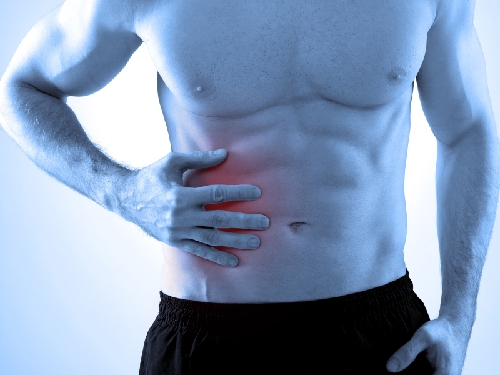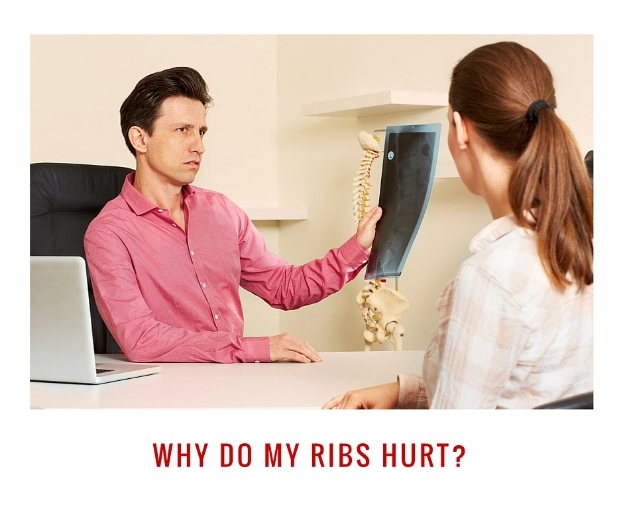 The ribs serve as an important protector that keeps many of your decidedly squishy organs from harm during everyday life.
The ribs serve as an important protector that keeps many of your decidedly squishy organs from harm during everyday life.
When pain comes from under or behind the ribs, we tend to take notice. The right rib cage protects many organs involved in the cardiovascular and digestive systems so any pain from under the right rib cage is likely to be connected to one of these.
Understanding possible culprits and what signs and symptoms to look for is the first step in seeking treatment and eventual relief. So if you’ve ever wondered “Why do my ribs hurt,” read on for answers.
In this article:
Pain Under Right Rib Cage: Causes
Injury
Technically, this would result in pain in the rib cage itself, but the distinction can be hard to make at times. Rib pain from injury tends to involve either the rib bones themselves or the intercostal muscles, which connect to the ribs. The nature of the injury will dictate the kind of pain you feel. Bruising or inflammation may produce a dull pain under the right rib cage or sore ribs in general, but a broken bone or fracture could cause a sharp pain instead.
If you have experienced recent physical trauma, then it’s important to be aware of the signs of a broken rib. If you have a sharp pain under the right rib cage when breathing, pressing on the area, or when bending or twisting your body, seek medical attention and evaluation immediately.

Gallstones
Your gallbladder is located behind the right ribs, and as a result gallstone pain can be felt coming from behind the rib cage. Gallstones (1) form when bile or cholesterol collects and hardens into a stone or crystal. Theses stones can create obstructions in the bile ducts, creating inflammation and pain that can come on with surprising speed. Gallstone attacks can create sudden, rapidly increasing pain under the right rib cage and back, between your shoulder blades. Additionally, you may experience jaundice (yellowed skin and/or eyes), fever, and chills.
Fecal Impaction
A fecal impaction is when a mass of dry, hard stool forms that the body is unable to pass. The impacted feces can fill up the colon, sometimes to the point where it can cause death if left untreated. Fecal impaction does not normally cause digestive symptoms save for occasional diarrhea as liquid stool manages to slip around the impacted mass. Instead, symptoms tend to appear as pain behind the right or left rib, depending on which part of the colon the mass is in, plus rapid heartbeat, a swollen abdomen, breathing problems, reduced urination, confusion, nausea, vomiting, and being unable to have a bowel movement.
Fecal impactions can form as a result of untreated constipation, opioid drugs, staying immobile for long periods of time, and laxative abuse, and in children it can be a result of functional constipation as well.
Appendicitis
The appendix is an apparently useless pouch attached to the intestines that can sometimes become blocked, allowing bacteria to build up and inflame the organ. If not treated, the appendix may burst and spread the infection throughout the abdomen, which is a potentially life-threatening situation.
Appendicitis (2) presents with sudden pain that may begin around your navel but will eventually shift towards the lower right of the abdomen, below the rib cage. Nausea, vomiting, loss of appetite, low fever that worsens over time, and abdominal bloating are all possible symptoms as well. In pregnant women, the pain may come from the upper right abdomen instead since the appendix shifts position during pregnancy.
Crohn’s Disease
Crohn’s disease results in inflammation of the large intestine. This can produce pain under the right rib cage after eating along with diarrhea, excess flatulence, blood in stool, and other unpleasantries. Unfortunately, while it’s known that certain foods can certainly aggravate Crohn’s disease, there is not much known about what actually causes the condition other than that there is a genetic component.
Running

Treating Pain under the Right Rib Cage
The exact treatment you should use when trying to resolve rib pain is going to rely on getting the cause accurately diagnosed. Due to how varied individual causes can be, the underlying problem must be understood in order for any true progress to happen:
Injury
If you suspect you have suffered an injury to the ribs, your doctor is going to want to take an X-ray. This will let them see if anything is fractured or broken and, if a break has occurred, if any organs are at risk of being poked or punctured. An MRI or CT scan may also be used to look at the soft tissue and detect injuries that wouldn’t show up on an X-ray. The good news is that broken ribs heal on their own after about six weeks, but in the meantime you may be prescribed pain medications and instructed in breathing techniques to help avoid pneumonia (a consequence of shallow breathing).
Gallstones
If you can’t pass the gallstones (3), surgical removal of the gallbladder may be called for. Medication exists that can help dissolve the stones, but this is not always reliable and it can take months or years for the full effect to be felt. If you do get your gallbladder removed (cholecystectomy), bile will flow directly from the liver to the small intestine, so you will still be able to eat food normally.
Fecal Impaction
There are several treatment options for fecal impaction, and all of them require seeing a doctor. In the mildest cases of impactation, a laxative may be able to force the passage of the hardened stool. In other cases, an enema may be employed to lubricate the feces and add moisture. Alternatively, water irrigation might be used to essentially “flush out” the mass. Manual removal (where the doctor sticks their finger into the rectum to break it up) or in the worst case, surgery, may also help.
Appendicitis
Treatment for appendicitis involves a combination of antibiotics and surgical removal of the appendix (appendectomy). Antibiotics alone may be able to treat appendicitis if the condition is caught early, but if the appendix ruptures then surgery must be performed. Sometimes abscesses will form on or near the inflamed appendix and these will need to be drained before an appendectomy can be done.
Running
A stitch will normally resolve itself after a period of rest without any medical or personal intervention. If, for some reason, the pain does not lessen or seems to be increasing, consider talking to your doctor about it.
Crohn’s Disease
Treatment for Crohn’s (4) is usually a multi-faceted affair that involves drugs such as anti-inflammatories and corticosteroids to try to treat the main symptoms. Immune suppression drugs may also be attempted since they have the ability to affect inflammation as well. Since Crohn’s can result in abscesses, antibiotics are not uncommon when trying to treat complications. Lastly, anti-diarrhea medication, pain medicine, and various vitamin supplements can also be prescribed alongside special dietary considerations.
Ultimately, pain from under the right rib cage is just one symptom that can be shared by numerous, varied conditions. The above list is not exhaustive but by paying attention to the symptoms and signs your body is showing and by informing your doctor, a diagnosis and plan of action will inevitably emerge.
Read Next:
